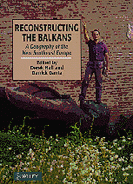
![]()

The authors and editors are right stating that the Balkans is a phenomenon itself. Let me add that it has always been so. When they say phenomenon, they mean the complexity of the questions raised in connection with the Peninsula. The Balkans have a common historical root which surfaces in the histories of the individual states. The Balkans, of course, has its own geographic character different from other parts of Southeast Europe. The Balkans has its own cultural ties and political identity that appear in various forms in the individual socio-political entities. Moreover, the Balkans rests on an image in European history as a fortress under siege by 'the Pagans' (the Ottomans) and in defence of European Christianity. From the nineteenth century onwards, the Balkans has also carried the image of a place with unsolvable troubles, be they fights between religions, nations, or ideologies.
In other words, using the Balkans as a context is a fruitful approach for describing and analyzing historico-political issues of the continent. Within this context, authors can formulate clear questions such as the relationship between world religions and their cultures (the Christian-Islam fight), the importance of the political traditions in modernization (the Balkan countries did not experience democracy in a way most of the societies in the rest of the continent did). The context leads us to raise burning issues of today like the fate of Bosnia-Herzegovina, the ethnic, national and religious revivals, and the dangerous Molotov-cocktail of powerful ideologies like socialism and nationalism.
The authors did wonderful jobs. Using their specific approach - called human geography or social ecology - experts from various geography departments from both sides of the Atlantic showed the reader the basic facts and underlying processes behind the news media. The authors give us lessons on how to understand terms like 'the Serbs' and why to use religious rather than ethnic or national designations. We also learn about the unusual complexity of societies from ethnic, religious, linguistic and cultural points. In short, an introduction like the present volume is a necessary, moreover, an essential tool to train ourselves in European tolerance and world complexity.
Of course there are facts which can be interpreted in different ways and statements that could be stated alternatively. In few cases they produce challenging results. Since the authors have taken the geography approach they start from the present time and look 'back' to history. The history of present day countries are political constructions rather than facts and, as such, they show divergence rather than convergence. The history of the Balkans cannot be built up from the individual pieces of national histories. If authors lose the broader horizons and sink down to individual histories, they have to take stand for one interpretation against others. This is the core dilemma of the authors (as well as present day peace- and policy-makers). Whose vision is closer to the Balkan reality: the vision of its inhabitants or the vision of the outsiders? The question is not solved, though the authors take pragmatic stands when they build a synthesis from the national theses/antitheses.
The traditional way to understand society is history. The idea of the historical analysis is deeply built in our mind: we feel ourselves safe if we can create a logical chain of events. Geography suggests an alternative way to understand society. It stresses the essential connections between human beings and their environment.
One of the benefits of an analysis like the present volume is the connections among space, time, and societal actions. The best chapters of the book combine those factors (especially in Section D). You may understand Serbs in Bosnia-Herzegovina if you understand the 'Serbian nation'. And you will understand that entity if you follow the Slavs in the Peninsula. But you have to understand Eastern Christianity to understand the Slavs, and you have to understand the role of Eastern versus Western Christianity in Southeast Europe to understand the essential difference between political culture, interpretation of history and everyday life in the Balkans.
Geography and geographers are great at creating those wider contexts and then looking back for detailed analysis. The most valuable parts of the volume are those when authors combine geography with a kind of social anthropological approach. Views of the Muslims in the Balkan peninsula, the fate of the non-Slavic inhabitants, the political, economic and environmental catastrophes - those are issues that are addressed by this powerful analytic approach.
Though the Peninsula has, as I pointed out, its own tradition in the European history of diplomacy, most of the book's potential readers were shocked stirring to the Bosnian slaughter. It is high time for Europe to learn more about its Eastern half. Hall and Danta offer a reliable curriculum. Europeans from both sides of their common continent must master it.
Tamas Kozma
HIER, Budapest